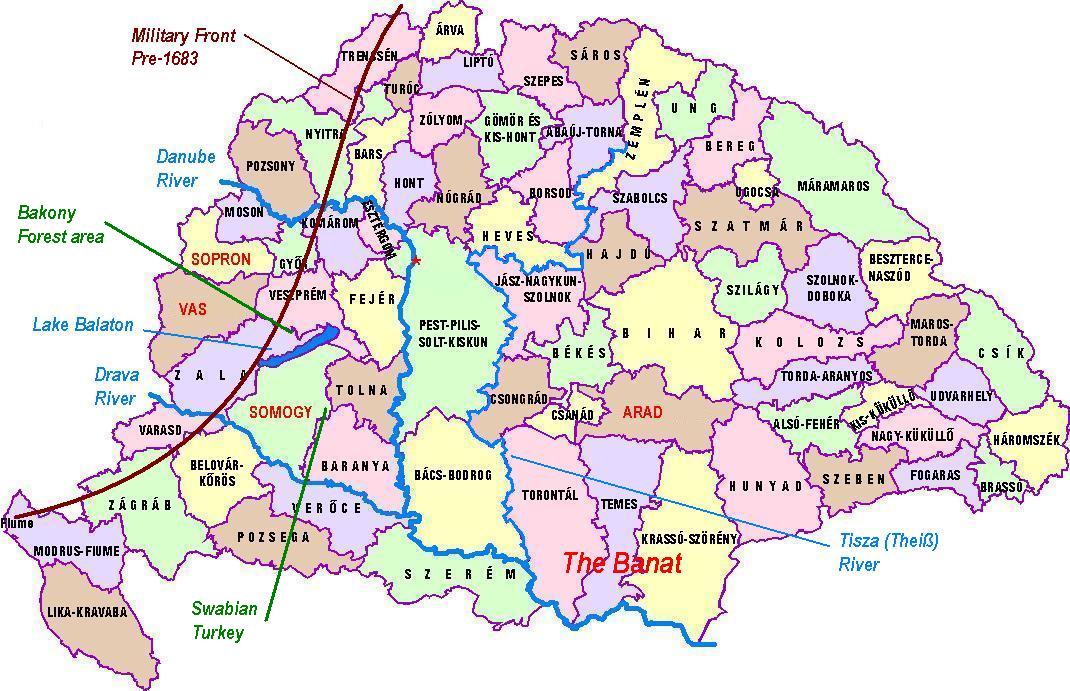|
The
|
THE BURGENLAND BUNCH NEWS - No. 208 March 31, 2011, © 2011 by The Burgenland Bunch All rights reserved. Permission to copy excerpts granted if credit is provided. Our 15th Year, Interim Editor: Thomas Steichen, Copy Editor: Maureen Tighe-Brown The Burgenland Bunch Newsletter is issued monthly online. It was founded by Gerald Berghold (who retired in Summer 2008 and died in August 2008). |
Current Status Of The BB: * Members: 1922 * Surname Entries: 6616 * Query Board Entries: 4554 * Number of Staff Members: 17 |
This newsletter concerns: 1) THE PRESIDENT'S CORNER 2) LATIN TRANSLATOR 3) SOMETIMES WE GET IT WRONG... 4) BB HOUSELISTS - FOLLOW-UP 5) BUSÓJÁRÁS CARNIVAL 6) FOLLOW-UP TO "EISENBERG-EISENBURG CONFUSION" 7) "REVISED" SOUTH BEND HUNGARIANS (by Gary Gabrich) 8) RESETTLEMENT OF WEST HUNGARY, POST-1700 9) TIPS FOR A TRIP IN BURGENLAND 10) HISTORICAL BB NEWSLETTER ARTICLES: SOME GENERAL HISTORICAL GEOGRAPHY AFFECTING VILLAGE NAMES 11) ETHNIC EVENTS (courtesy of Bob Strauch, Margaret Kaiser & Kay Weber) 12) BURGENLAND EMIGRANT OBITUARIES (courtesy of Bob Strauch) |
1) THE PRESIDENT'S CORNER (by Tom Steichen)  This
month we present a research article (Article 8) concerning the resettlement of Hungary in the 1700s, after the 150+
years of Ottoman Turk occupation and domination that ended in 1683. Article 5 is coincidentally related to Article 8...
read it and you'll learn why. This
month we present a research article (Article 8) concerning the resettlement of Hungary in the 1700s, after the 150+
years of Ottoman Turk occupation and domination that ended in 1683. Article 5 is coincidentally related to Article 8...
read it and you'll learn why.Articles 3 and 9 share some Staff discussion resulting from messages sent to the BB. Number 3 shows that we are human... in that our first responses to the writer were completely wrong (at least we corrected ourselves later). The other article updates advice about traveling in Burgenland. Article 2 introduces a new resource for the BB. Latin (and Italian) teacher, Raffaele Di Zenzo, has agreed to provide (fee-based) translation services for the Bunch. This was not a capability within the current Staff, so it is good to have someone to direct you to. Three articles (4, 6 and 7) are follow-ups to articles published in recent months. One of the benefits of publishing information is that it opens up the topic for review and comments by all of you... invariably, at least one among you has something worthwhile to add! We, of course, also present the Ethnic Events calendar and the Emigrant Obituary sections. I terminate my "Corner" with a bit of ethnic humor (at the expense of my home state, Minnesota). The Ten Commandments, Minnesota Style... Minnesota is a bit of a microcosm, with ethnic settlement locations that often emulated their positions in Europe. The Finns settled the north-east, the Norwegians the north-west, Swedes and Germans dominated the central regions, Slavs had numerous small enclaves in the south, and our Burgenlanders settled predominantly in inner-city Minneapolis and St. Paul, over on the south-central eastern edge of the state. Nonetheless, a Scandinavian influence tends to dominate the perception of Minnesota (perhaps because of the Kensington Runestones, the claimed Norse discovery of Minnesota in the 1300s and the Minnesota Vikings), so the state as a whole is often tagged with being "Scandinavian." Given that, it is no surprise that some wag has rewritten the Ten Commandments in Scandinavian-speak... I hope you enjoy this ethnic twist:  The Ten Commandments:
The Ten Commandments:1. Der's only one God, ya know. 2. Don't make dat Stuffed Walleye on your mantel an idol. 3. Cussin ain't nice. 4. Go to church even when you're up Nort. 5. Honor your folks. 6. Don't kill; catch and release. 7. There's only one Lena for every Ole, so no cheatin. 8. If it ain't your lutefisk, don't take it. 9. Don't be braggin bout how much snow ya shoveled. 10. Keep your mind off your neighbor's hot-dish, OK? |
2) LATIN TRANSLATOR New member Chris Hegyi recently joined the BB. He wrote: "I have several pages of nobility documents that I am wanting to have translated from Latin to English. They are from the late 1700's to early 1800's. I am willing to pay to have these translated. Do you know of anyone who can help?" Since I do not have personal experience with any Latin-to-English translators, I copied the BB staff in the hope that maybe one or more had worked with a translator that they might recommend. Contributing Editor Emerich Koller replied saying: "I have a very capable Latin translator with a PhD in Latin. His name is Raffaele Di Zenzo. His e-mail address is raffaeledz@aol.com. Get in touch with him for details." So I did, inquiring whether Raffaele would be willing to accept paid work from BB members, what his training in Latin was, and any "business" details he could share about how this would be done. Raffaele graciously replied: I received your e-mail regarding some Latin translations. Mr. and Mrs. Emmerich Koller and I are great friends, therefore I will accept the translating role of your Organization. In fact, at the present time I am working on translating a handwritten (and challenging) genealogical document for Mr. Chris Hegyi. Briefly, I was born in Italy, where I attended the Liceo Classico (which is a 5 year classical High School, dedicated to the study of Latin and Greek). Upon coming to the United States, I continued my studies at the University of Illinois at Chicago and at the Urbana campuses, from which I received a Ph.D. I have been teaching Italian and Latin for many years. Scanned copies or photocopies are ok. I will ask for originals if either the photocopies or scanned copies are not well legible. Regarding the honorarium, it is quite difficult at this time to establish a price. It depends on various factors: how many pages, the difficulty in reading the handwritten manuscripts. At minimum, it will be around $100 per page. Regarding time, it also depends on the difficulty of the manuscript; I need at least a week per page. My home address is: Raffaele Di Zenzo, 2946 Sunnyside, Westchester, IL 60154. So, if you have some Latin documents that you desire to have translated, send Raffaele a message at the above email address and work out an arrangement. Having personally attempted to decipher and transcribe old, often poorly scanned or photographed, handwritten documents (necessary steps prior to and during translations), I know that Raffaele's minimum payment and time estimates are quite reasonable. Usually, you have too little of an author's writing style to fully sort out what each letter or word is. Therefore, it takes some guess work, a basic understanding of the type of document involved, and multiple reviews before you can properly reconstruct the message. This quickly lowers the effective hourly "rate" for such work! If you do have Raffaele do some work related to Burgenland documents, please kindly share the scanned image and resulting translation with me. I'll include it in the newsletter or post it on the BB website so we can all benefit from your investment. I'm sure there will be something about your document worth sharing! |
3) SOMETIMES WE GET IT WRONG... The Burgenland Bunch staff routinely provides assistance to new members; and we even have a few staff members whose primary duties are to provide such help. Often we are able to point out resources that will help our newer members research their family history in Burgenland. However, there is the occasional potential new member where their family surnames appear inconsistent with what our experience says are "Burgenland" names and/or the emigrant village is clearly not in our region. Because our membership policy is to require some connection to Burgenland, we try to redirect these folks to the regions or resources appropriate for them and we do not add them to our membership roll. We do this because, if Burgenland is the wrong region, their membership does them no good nor does it help current members. Things get a little more difficult when the new member
has reason to believe their surnames are from Burgenland but don't know any specific locations. A recent case like this is
that of new member Terry Gardner. Terry provided the surname "Streier," no emigrant village (just "Burgenland"), and
settlement location, Eden, SD.
And that, folks, caused us (the staff) to get it all wrong! |
4) BB HOUSELISTS - FOLLOW-UP In Newsletter 206, I made passing mention of the BB Houselist project being run by Klaus Gerger. That mention came about when member Kathy Ettel Middendorf inquired, Is that "Houselist" page still being actively worked on in BBunch? I noticed Halbturn has not been done, and I was wondering if that is something I could do "online". The answer, as you may recall, was that it was (and still is) an active project and that Klaus is always looking for recruits to help transcribe the material. I then asked Klaus to explain what needs to be done. His reply was that any help transcribing lists is very welcome and that the procedure was straightforward:
OK, lets talk about excuses why you can't do this... |
5) BUSÓJÁRÁS CARNIVAL Margaret Kaiser also kindly forwarded to me an article from website "The Hungarian Girl" (http://thehungariangirl.com) about the Busójárás Carnival in Mohács, Hungary, a celebration which is held exactly seven weeks before Easter, meaning it was held this year from March 3rd through 8th. Given that timing and the fact that we publish the BB Newsletter on the last day of each month, Margaret's message arrived too late to be "news" in the February Newsletter and, by publication of this current (end-of-March) newsletter, it was already past history (if you want to participate, you'll have to go next year!). Nonetheless, Margaret's timing was perfect! So—as I'm sure you are saying to yourself—why would I claim this? The answer is that both the location of the Carnival (Mohács) and its legend (more on that below), are highly relevant to Article 8, entitled "Resettlement of West Hungary, Post-1700" and being the major research article in this newsletter. In that article, we speak of the ~150 year intrusion of the Ottoman Turks into Hungary, who invaded in 1526 and occupied until 1683, and the eventual resettlement of that land after the Turks were driven out. Let me first tell you about the Carnival so you can see why it relates... The Busójárás is a carnival, pagan in origin, where revelers come to celebrate the end of winter with a spring ritual intended to appease the gods. As noted above, it is held seven weeks before Easter, lasts 6 days and, here is the oddity, involves dressing up 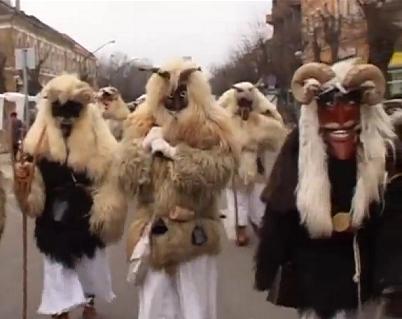 in sheepskin costumes and scary masks and cranking on noise-makers! It also includes crafts, folk music, parades and
dancing.
in sheepskin costumes and scary masks and cranking on noise-makers! It also includes crafts, folk music, parades and
dancing. According to legend, the carnival, in its current form, originated with the Šokci (Croats) living in Mohács during the 17th century. These villagers co-opted the ritual to frighten away occupying Turkish forces and rid them from the land. Well, if you know your Hungarian history, the key Ottoman military victory over the Hungarians took place at Mohács in 1526. Within 3 years after that, the Turks had pressed close to Zagreb and were camped in siege around Vienna, in the process becoming a major threat to all of middle and western Europe. It would not be until 1683, 157 years later, during a second siege of Vienna, that the Holy Roman Empire would prove strong enough to thwart the Ottoman Empire's war machine and begin to drive them out of Europe. Perhaps it was the Busójárás rituals of that time that changed the tide... perhaps not too! Nonetheless, I'm sure the locals claim a little "credit." Today, the Mohács Busójárás Carnival is a popular attraction for visitors who come to experience its unique traditions. Similar carnivals have now spread into Serbia, Slovenia and Croatia, homelands of many of the participants and revelers at Mohács. If you are interested, you can watch a nearly 10 minute video about the Mohács Busójárás Carnival on YouTube at link www.youtube.com/watch?v=dVW4_NEV7_M. You may also want to check out "The Hungarian Girl" at the link listed at the top of this article. This website is the creation of Suzanne Urpecz, a Toronto writer and researcher who specializes in Central and Eastern European travel, food, and wine. |
6) FOLLOW-UP TO "EISENBERG-EISENBURG CONFUSION" In a comment on the February 28th Newsletter (#207) article, "Eisenberg-Eisenburg Confusion," Richard Potetz wrote to say:
|
7) "REVISED" SOUTH BEND HUNGARIANS (by Gary Gabrich) I humbly stand corrected, whereby in my article in newsletter #206, "The First Hungarian in South Bend," I indicated that a Mr. Steven Wartha was the first Hungarian in South Bend, arriving there in 1881. Mr. Hannes Graf graciously indicated that, in archived newsletter #130A, there is an article and obituary on Mr. Andreus Schrier, who was born in Tadten around 1855 and arrived in South Bend with his wife in 1880. It is worth reviewing this article, which indicates that other Burgenlanders used Mr. Schrier (Schreyer) as sponsor when arriving in the South Bend community. Recent new databases for South Bend Burgenlanders For those Burgenland Bunch members who have or had ancestors that lived here in 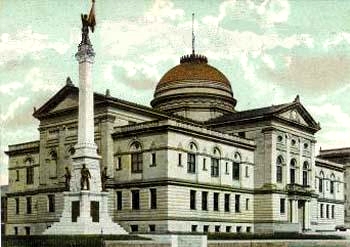 South
Bend, Indiana, you can now access data covering all marriages from 1920 to 1989 that was compiled by local citizens and
put on our GenWeb site. In particular, there is a spreadsheet of marriages, starting in 1802, from St. Mary’s German
Catholic Church, which served Hungarian Germans and the first Hungarians. St. Stephen’s Hungarian Catholic Church served
Croatian Hungarians and its records start about 1890. These early marriage databases include the parents’ names, the names
of the villages where born, and ages, if known. South
Bend, Indiana, you can now access data covering all marriages from 1920 to 1989 that was compiled by local citizens and
put on our GenWeb site. In particular, there is a spreadsheet of marriages, starting in 1802, from St. Mary’s German
Catholic Church, which served Hungarian Germans and the first Hungarians. St. Stephen’s Hungarian Catholic Church served
Croatian Hungarians and its records start about 1890. These early marriage databases include the parents’ names, the names
of the villages where born, and ages, if known.Chris Kovach, a dedicated young man, has spent the last seven years compiling databases and compiled the bulk of this info. As an example of other work, he created spreadsheets of all the Hungarians found in the 1900, 1910, 1920 and 1930 censuses—the 1930 spreadsheet alone had 9,500 entries. These spreadsheets are a great tool for finding basic information. If you need more information, you can contact our local Rootsweb Query Board, the local St. Joseph County Public Library or me. If you would like to explore these databases, go to http://www.rootsweb.ancestry.com/~instjose/ (St. Joseph County, Indiana GenWeb). Scroll down until you find box title "Marriage Records" in the middle row. Go to the bottom of that box and click on "Marriages 1921–1924" by Chris Kovach. Don't click on "Marriages" yet, rather, scroll down to the list of churches and click on "St. Mary of the Assumption" for the Germans or "St. Stephen's" for the Croatians and Hungarians. Since it is a spreadsheet, you can sort and list alphabetically by groom or bride surnames. Be careful on the spelling, since the church recorder didn't always correctly spell the names or the home towns. After you close this file, you might go to the top of the Kovach page and click Chris' "Marriages" link to find all marriages in St. Joseph County during 1921–1924. When done with that file, exit it and use your Back button to go to the main St. Joseph County page, then click "Marriage Records," which is a new index of all County Marriage Records from 1922 to 1989 -- except Mishawaka, which we are currently working on. A group of seven of us volunteers have been working on this index for two years! Finally, you might also scroll down the left column on the St. Joseph County page until you get to Chris Kovach’s "Hungarian Immigrant Collection." This is a treasure-trove of information. Of particular interest would be the "Vital Records Extraction," which indexes Birth, Marriages and Deaths from the two Catholic churches, the Hungarian Reformed Church and the local cemeteries. Also, see his census information and other interesting articles. Feel free to contact me, Gary Gabrich, personally for additional info. |
8) RESETTLEMENT OF WEST HUNGARY, POST-1700 The Burgenland has a long history of being frontier country. Even up to quite recent times, its eastern border was part of the "iron curtain" defining the frontier separating Eastern and Western Europe. As a result, Burgenland has a history of being a mixing pot of ethnicities, religions and societies. During much of the 16th and 17th centuries, the Ottoman Turks occupied central and southern Hungary, using it as a staging ground on its assaults on Vienna and Middle Europe. Western Hungary became a battle ground where armies clashed; Burgenland itself was behind the temporary front lines when the Turks twice set siege to Vienna. By the time the second siege was broken in 1683, 150 years of occupation and war had devastated and depopulated much of Hungary. These facts led Mary Reilly, the BB E-mail List Manager, to ask when & how Hungarian landowners recruited German settlers to repopulate Hungary, saying "I know they offered a "tax break" -- relieved of all taxes for 3 years, along with receiving land. I know that after the Turkish occupation & the plague epidemic, Hungary's population was down... Do you know anything about this?" Well, it was not a topic I knew much about... but it did seem worth investigating... so I invited the BB Staff to report whatever they knew about the subject, especially as it pertained to the region of West Hungary that became Burgenland, promising also to dig into the topic myself. To give the effort direction, I stated a number of questions: 1) What were the facts on Hungarian population size changes around 1700? 2) When did the recruitment start? 3) How was the actual recruitment done? 4) What were the incentives that were offered? 5) Why German settlers (rather than other ethnicities, in particularly Hungarian)? 6) How did the post-1700 influx differ from the earlier Croatian migrations that Frank Paukowits had recently written about? 7) What historical documents exist concerning the recruitment and its effects? Interestingly, although the Staff responded as they always do, I was slightly frustrated because the responses either targeted an earlier period or tended to speak of resettlements in central, eastern and southern Hungary. The references I found in my own research were also off target temporally or location-wise. So why was this true? The simple answer is that the main thesis of the question, when directed specifically at Burgenland, was wrong! Burgenland, as a whole, was never extensively occupied nor largely depopulated... yes, armies marched (or fled) through it, but the duration behind the Ottoman military line was measured in months—not the 150 years that most of Hungary endured. One can assume that villagers, who could, fled ahead of the Ottoman army... but they almost certainly returned shortly after the Habsburgs and allies drove the Turks back. The map below shows the extent of extended Ottoman occupation. It was in 1526 that the Ottoman army of Sultan Suleiman I defeated the forces of King Louis II of Hungary at the 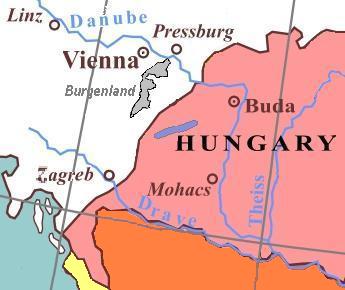 Battle
of Mohács. Over the next three years, the Turks advanced their front to nearly Zagreb in the south and to beyond Lake
Balaton and Budapest in the north. In late September 1529, Suleiman pushed his tired and depleted army forward for an
opportunistic first siege of Vienna, but the siege lasted only a few weeks before the Ottoman supply logistics proved
inadequate. In mid-October they slaughtered those prisoners not worth taking with them and retreated to Buda. The invasion
and its siege exacted a heavy price from both sides, with tens of thousands of soldiers and civilians dead and thousands
more sold into slavery. However, it also marked the end of the Ottomans' expansion towards the centre of Europe and
arguably the beginning of their long decline as a dominant power. But it would not be until 1683, 157 years later, that
the Habsburgs and the Holy Roman Empire would be both strong and determined enough to push the Turks out of Hungary. Battle
of Mohács. Over the next three years, the Turks advanced their front to nearly Zagreb in the south and to beyond Lake
Balaton and Budapest in the north. In late September 1529, Suleiman pushed his tired and depleted army forward for an
opportunistic first siege of Vienna, but the siege lasted only a few weeks before the Ottoman supply logistics proved
inadequate. In mid-October they slaughtered those prisoners not worth taking with them and retreated to Buda. The invasion
and its siege exacted a heavy price from both sides, with tens of thousands of soldiers and civilians dead and thousands
more sold into slavery. However, it also marked the end of the Ottomans' expansion towards the centre of Europe and
arguably the beginning of their long decline as a dominant power. But it would not be until 1683, 157 years later, that
the Habsburgs and the Holy Roman Empire would be both strong and determined enough to push the Turks out of Hungary.We'll talk about 1683 and the second siege of Vienna further below but, first, a few speculations about the effects on Burgenland of the Ottoman advance and retreat at the time of the first siege of Vienna. I say "speculation" because hard facts are difficult to find. The small piece of West Hungary now known as Burgenland figured so little in the bigger picture of Ottoman advance into and 150 years of occupation of Hungary that few documented effects made it into contemporary history books. Instead, we must speculate on effects based on what is known to have occurred elsewhere. First, the Ottoman advance on Vienna was carried out in the Danube valley—as was the later retreat—so the Turkish fleet could support the army. This means that the major movement of the Ottoman army likely only affected the very northern reaches of Burgenland, as the army advanced overland between Pöszöny (Pressburg / Bratislava) and Vienna and its foragers pillaged the surrounding countryside for prisoners and supplies. The Neusiedler See almost certainly funneled most military movement to its north, so it is unlikely that middle or southern Burgenland was directly impacted in any significant way. However, desertion from the Ottoman ranks was an issue; it seems logical that groups of deserters were more likely to head south along the west side of Neusiedler See rather than east toward the rear ranks of the Ottoman army. These deserters likely carried out small-scale theft but were probably more intent on remaining unobserved than they were in doing significant damage. In addition, the duration of the first siege was but a few weeks; far too short for foragers to range deep into Burgenland. One could presume that the current-day State of Lower Austria, especially to the east of Vienna, and the Heideboden area of the Neusiedl district sustained the bulk of the damage, both in plunder and wanton destruction, with some damage extending into parts of Eisenstadt. Barbara Raabe pointed out a reference (Allgemeine Landestopographic des Burgenlandes. Der Verwaltungsbezirk Neusiedl am See, Eisenstadt, 1954; translated and summarized by Albert Schuh) that indicates that Wallern, a village at the southwestern edge of the Heideboden flat lands north and east of the Neusiedler See, was destroyed by the Turks in 1529... but soon rebuilt. To me, the quickness of the rebuilding suggests that the prior residents reclaimed their lands after the army was gone. Mary Reilly, the Staff member whose comments prompted this article, pointed out material based on the book, Das War Zanegg, the Heimatbuch of Zanegg in Moson County (Weisselberg) in Western Hungary (Johann Neuberger, 1989; translated by Henry Fischer), which supports this view. Neuberger says the Turks passed through the Heideboden and destroyed most of the settlements on the way to and from Vienna, massacring or enslaving those who did not flee. However he also notes that many in the Heideboden fled to the islands in the Neusiedler See, to the swamps and forests in the south, or into Austria. These, he says, eventually came out of hiding and began to rebuild, reclaiming most of the larger settlements but leaving the smaller ones to revert to wilderness. At least twelve such smaller settlements are documented as unreclaimed. More important to central and southern Burgenland was the siege of Vienna planned for 1532. That intended siege was delayed and eventually diverted by unsuccessful attempts to reduce the Hungarian fort at Köszeg, near the present-day border of Burgenland. With winter coming on and the reduction incomplete, the Ottoman troops retreated through and laid waste to Styria. Both the sustained encampment around Köszeg, with its extended foraging and ravishment of surrounding lands, and the march through Burgenland to attack Styria, almost certainly devastated and depopulated some of the central and southern regions of Burgenland. In fact, it is believed that these two campaigns (the first siege of Vienna and the Köszeg reduction and march through Styria) left behind enough destruction in Austria and Habsburg Hungary to impair the Habsburg's capacity to mount a sustained counterattack. The effect was to consolidate the gains of 1526, establish a puppet kingdom in Hungary as a buffer against the Holy Roman Empire, and put off final resolution for five generations. Although six additional wars would take place between the Turks and the Habsburg allies in the ensuing years, none directly affected Burgenland. So what do we know of the 150 years of comparative peace for Burgenland after 1532? BB Newsletter 60 quotes a 1650 proclamation which indicates that, even a hundred-plus years later, resettlement in Burgenland was still needed:
This document shows that areas of Oberwart had lost villages sometime in the recent past ("for there shall be
villages in this place in the future, as there have been in the past") and that the benefit of moving there was a
period of up to three years in which taxes and Robot service were exempted (plus some unstated amount of land). It is
notable that Castle Schlaining lies only a dozen miles west of Köszeg along the valley route west into Styria (Castle
Rechnitz also lies along the same valley but even closer to Köszeg). Whether the destruction of the aforementioned past
villages occurred during the 1532 retreat through Styria is unknown, however, the BB Village History for Bad Tatzmannsdorf
(a village which is only a few miles west of
Klaus Gerger also provided some insight, citing two books by Franz Theuer [Brennendes Land - Kuruzzenkriege. Ein
historischer Bericht (Burning Land - Kuruzzen War. A Historical Account), 1984; and Verrat an der Raab - als
Türken, Tataren und Kuruzzen 1683 gegen Wien zogen (Betrayal of the Raab - as Turks, Tatars and Kuruc 1683 Moved to
Vienna), 1976]. He says that the books indicate that "Burgenland was not (much) affected during the getaway of the Turkish
troops after the relief of Vienna. Burgenland is so close to Vienna and the troops (at that time you could not call them
troops anymore, just fleeing hordes) tried to get as many miles, as fast as possible, between them and the victorious
army." |
9) TIPS FOR A TRIP IN BURGENLAND Member Carole Kannapes Quinn posed a simple question that led me to consult the BB Staff: "Hi, I'm going to be in Vienna in May. I hope to go to Gussing and Tobaj where my father is from. I have family that I have never met. Any tips?" I replied: It is over 10 years since I've been in Burgenland, so my advice would be quite out of 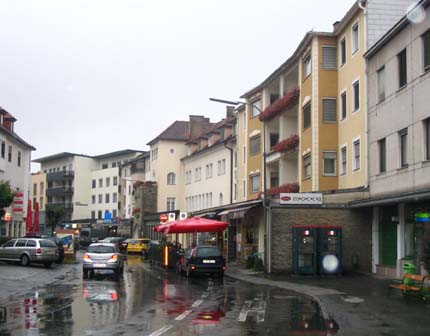 date.
However, I'm copying my reply to the BB Staff in hopes that they have more relevant advice. So, to the Staff: Please reply
to Carole with whatever advice you have for traveling in Burgenland (to Güssing and Tobaj from Vienna) in May and meeting
with family members that you have never met. In addition, please copy me, as I think we are overdue on a newsletter
article on the topic! I suspect we have older advice articles in the archives (but I have not checked yet). Regardless,
with the advent of the Euro, the border open, and years gone by, we need to do an update. I hope you have a great trip,
Carole, and that the Staff can be helpful. date.
However, I'm copying my reply to the BB Staff in hopes that they have more relevant advice. So, to the Staff: Please reply
to Carole with whatever advice you have for traveling in Burgenland (to Güssing and Tobaj from Vienna) in May and meeting
with family members that you have never met. In addition, please copy me, as I think we are overdue on a newsletter
article on the topic! I suspect we have older advice articles in the archives (but I have not checked yet). Regardless,
with the advent of the Euro, the border open, and years gone by, we need to do an update. I hope you have a great trip,
Carole, and that the Staff can be helpful.This, of course, caused a number of replies... Matt Boisen jumped right in: Hi Carole, what a great trip. I envy people who already have contacts in Burgenland. But we enjoyed ourselves immensely when we went in September of 2003. The big thing is to take your time, there's no giant autobahn to worry about and so much to see (and eat). We rented a car out of Vienna airport and were in the country quickly. We crossed the border several times, to Sopron and Köszeg and a couple of other Hungarian villages I can't recall. The border guards were still there,  but
just waved us through. Go to the farmer's markets, good stuff, and great people watching. Make sure you look for local
cuisine, much of it is "peppery-er" as my wife said, but familiar... didn't find my grandpa's favorite dish,
krautknockerl, but it wasn't from a lack of trying. I suppose such "peasant food" is a thing of the past. Try as much wine
as you can. The Blaufrankisch and the Gruner Veltliner were our favorites. We just drove up to the wineguts as we saw
them. Sometimes, there's a brush of evergreen hanging over a door. but
just waved us through. Go to the farmer's markets, good stuff, and great people watching. Make sure you look for local
cuisine, much of it is "peppery-er" as my wife said, but familiar... didn't find my grandpa's favorite dish,
krautknockerl, but it wasn't from a lack of trying. I suppose such "peasant food" is a thing of the past. Try as much wine
as you can. The Blaufrankisch and the Gruner Veltliner were our favorites. We just drove up to the wineguts as we saw
them. Sometimes, there's a brush of evergreen hanging over a door.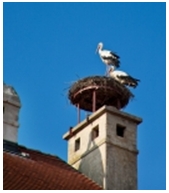 A
really cool thing would be the storks. They were gone to Africa by the time we were there, but the villages around the
Neusiedler See have stork nests on their roofs that are occupied during the summer. A
really cool thing would be the storks. They were gone to Africa by the time we were there, but the villages around the
Neusiedler See have stork nests on their roofs that are occupied during the summer.Even if you are fluent in German, don't pretend you can speak Austrian, let alone Burgenlander German, unless you were born and/or raised by, a Burgenlander. I still said my "Gruss Gotts" and "dankes" but I couldn't understand a thing they were saying. Instead of "ja" it's "JO". We went to Mass one Sunday and were completely at home with the service, even in Burgenlander German. The people are very down to earth and friendly. We liked the Liszt museum in Raiding, I think it has been remodeled since we were there, but it's a good one. Rust, and Mörbisch are good towns to visit. Lockenhaus and Bernstein are good castles to visit. Just take it slow and enjoy it. It'll seep into your bones. Frank Paukowits spoke up too: Hi Carole - I have visited Vienna and Burgenland a number of times over the last decade. I did a trip report for one of the visits. It's in Newsletter #157 (November 2006). I suggest you take a look. You might find information there that may prove to be useful. Additionally, in my last visit I stayed at the Hotel Austria in  Vienna
and had a very enjoyable stay. I would recommend this hotel over the Prinz Eugen where I stayed in my 2006 visit. If you
are going to rent a car, which I assume you will, I would suggest either Kemwel or Europcar, which have the best rates. Vienna
and had a very enjoyable stay. I would recommend this hotel over the Prinz Eugen where I stayed in my 2006 visit. If you
are going to rent a car, which I assume you will, I would suggest either Kemwel or Europcar, which have the best rates.In my last visit, I stayed at the Com.Inn, which is conveniently located between Güssing and Tobaj. It's a motel. If you want to try a Gasthaus to get a more local feel either stay at Kedl's Gasthaus or Guttman's (never stayed there, but my cousin does and he visits every year). Guttman's Gasthaus is conveniently located in Deutsch Tschantschendorf, which is right next to Tobaj. 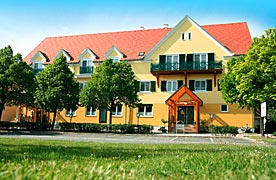 Places
where you should definitely eat are the Güssing Burg, where the ambiance is great and the food good... and surprisingly
reasonably priced, [and] the Schwabenhof in Hagensdorf. It's a 15-minute ride from Tobaj, but well worth the trip. Places
where you should definitely eat are the Güssing Burg, where the ambiance is great and the food good... and surprisingly
reasonably priced, [and] the Schwabenhof in Hagensdorf. It's a 15-minute ride from Tobaj, but well worth the trip.I am sure you will have a very enjoyable and rewarding trip. If you want any other information, please fell free to e-mail me at paukowits1@aol.com. Be well. And Klaus Gerger sent his regards and advice: Hello Carol, not much to add, just a few things. If you want to have paper brochures for the Southern Burgenland region you can order at: http://www.suedburgenland.info/de/service/prospektkatalog/suedburgenland/. Here you can download all the brochures as PDF or order paper (for free). If you struggle with the German website, please send me your surface mail address and I'll order for you. 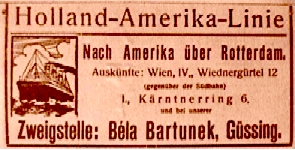 Another
must see is the "Auswanderer Museum" in Güssing. If you are not in Güssing during the regular open hours please let me
know. Perhaps we can arrange a tour outside the normal schedule. Another
must see is the "Auswanderer Museum" in Güssing. If you are not in Güssing during the regular open hours please let me
know. Perhaps we can arrange a tour outside the normal schedule.I can give a few hints on touristy places of interest. Visit the Güssing castle - including ~141 steps up to the bell tower, which gives a wonderful view over the area. Being in Güssing, the monastery and church is a must view. If one of the Franciscans has time to show it to you, the Batthyány crypt under the church is impressive. On the way to the castle you can see the cemetery of the old parish church, St. Jakob, from the 1200s. 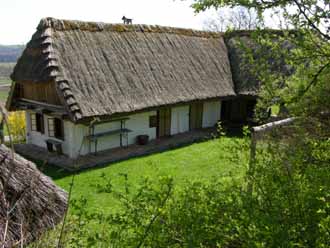 Close
to Güssing, there is an open-air museum (http://www.freilichtmuseum-gerersdorf.at/)
in Gerersdorf (6 km west of Güssing), where you can see the houses your ancestors lived in. Close
to Güssing, there is an open-air museum (http://www.freilichtmuseum-gerersdorf.at/)
in Gerersdorf (6 km west of Güssing), where you can see the houses your ancestors lived in. If you are technically interested, there is a museum on techniques used on farms http://www.landtechnikmuseum.at/ in St. Michael, 10 km north of Güssing. I'll think over the topic in the next days, perhaps I will come up with more tips. |
10) HISTORICAL BB NEWSLETTER ARTICLES Editor: This is part of our occasional series designed to recycle interesting articles from the BB Newsletters of 10 years ago. This month, however, we go back to 1997 and the 3rd newsletter Gerry ever distributed (I didn't find anything from 10 years back that I felt warranted being republished). Those earliest newsletters tended to be basic "how-to" instructions on Burgenland research... see for yourself: THE BURGENLAND BUNCH NEWS No. 3 January 27, 1997 SOME GENERAL HISTORICAL GEOGRAPHY AFFECTING VILLAGE NAMES The first step in looking for the location of a Burgenland ancestor's village is to consider the time frame of the particular ancestor's birth. Generally, your "Auswanderung" (the 1880-1914 US emigration period) ancestor's village will carry a Hungarian name. Later emigrants' villages will carry the German name. Pre-1848 records, as far back as 1648, can carry German, Latin or Croatian names. Post 1921 names will be in German (if in Austria) or in Hungarian (if in Hungary). To trace a family through time, it is necessary to know at least the Hungarian and German village names. It may also be necessary to know their Latin or Croatian equivalents and common abbreviations such as "N-júvar" for Németújvar (Güssing). (It really isn't proper to use the word "Burgenland" for any period prior to 1921, when the Province of Burgenland in Austria was born. It is very tiresome, however, to constantly be defining this geographic term. I will thus use the term "Burgenland" to define today's Austrian Province as well as that pre-1921 portion of Hungary along its western border, which was ceded to Austria.) 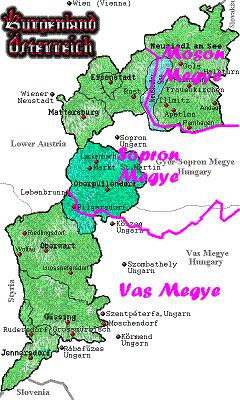 Most
of the Burgenland was formerly in Hungary's Vas Megye, although some villages may have been in any of the border counties
(north to south), Moson, Sopron, or Vas. While I can make do with a Hungarian map of Vas Megye, some genealogists may also
require one for Moson or Sopron. It is the county maps which supply the detail necessary to find the smaller villages. Most
of the Burgenland was formerly in Hungary's Vas Megye, although some villages may have been in any of the border counties
(north to south), Moson, Sopron, or Vas. While I can make do with a Hungarian map of Vas Megye, some genealogists may also
require one for Moson or Sopron. It is the county maps which supply the detail necessary to find the smaller villages.[Ed. note: The statement by Gerry that most of Burgenland was in Vas Megye is, of course, incorrect. While Vas was the Megye that individually contributed the most territory, Moson and Sopron combined contributed more (~2300 km2 vs. ~1600 km2 from Vas). The map to the right shows the old Megye boundaries overlaid on Burgenland (the map evidently distorts these areas some, making the south larger comparatively than it actually is). Gerry's early interest (this article is from Newsletter #3, after all) was clearly centered around Güssing in southern Burgenland, from where his family emigrated. Like all of us, he learned much during his years of writing the newsletter. I'm sure he would have cringed over that statement had he reread this article in his later years! This does not, however, detract from the generally excellent research advice presented in this article.] As we move back in time, we find that the names often change. Vas, pre-1830, becomes Castriferrei and Németújvar (Güssing) was alternately known as Kussen (AD 1263), civitas Vywar (1427), Nemethwywar (1466), Gyzzing (1582), Gissing (1619), Gyssing (1683), Nemet Uyvar Varos (1693) from which the Hungarian Németújvar stems and finally Güssing (1751 to present). If you search the literature for the periods indicated, you should be aware that there may be an older name of your village. GERMAN-HUNGARIAN-CROATIAN EQUIVALENT VILLAGE NAMES Keeping the foregoing in mind, it will generally be sufficient to know the 19th Century names of your village. The Austrian/Hungarian officials could be just as confused as we are and at least two important studies were undertaken. These resulted in two fine gazetteers, which are available on film from the Family History Center of the LDS in Salt Lake City. They are:  "The
Topographical Lexicon of the Communities of Hungary Compiled Officially in 1773", published by the Delegation of the
Peace of Hungary (LDS microfiche 6001476). "The
Topographical Lexicon of the Communities of Hungary Compiled Officially in 1773", published by the Delegation of the
Peace of Hungary (LDS microfiche 6001476).This is an alphabetic list of all places situated in the territory of each parish by county. It is not necessary to know the parish. If your village is not in one parish, look in the other three. Headings are in Latin. The lexicon lists the Latin, Hungarian, and any German or Slavonic name of each community as well as the predominant religion and language. Photocopies of pages 79-98 will give you a complete list for Comitatus Castriferrei (Vas Megye). It can also be used for information concerning border villages that are part of Hungary today. An example: Keresztúr, in the parish of Laky, is known as Keresztúr (later changed to Rába Keresztúr) in Hungarian and Heiligs Kreutz (Heiligenkreuz) in German. Catholic and German. "Gazetteer of Hungary" ["Magyarország Helységnévtára"] by János Dvorzsák, pub. in Budapest in 1877. (LDS microfiche 6000840. You need not order this fiche; it is part of each Family History Center's permanent microfiche collection. [Ed note: Also available online at Family History Archives at Brigham Young University or at Pécs University]) This is a very important gazetteer (written in German & Hungarian with an English introduction), as it was published right prior to the "Auswanderung" and thus uses names that would have been familiar to the immigrants; the names which they would have used on documents. It is arranged by county (Megye-Comitat), by district (Járás-Bezirk), then alphabetically by Hungarian community name. (If only the German name is known, refer to index for the Hungarian name). It shows the Hungarian name, German-Croatian equivalent, if any, number of residents by religion and where they attended church! Pages 743-773 will cover Vas Megye. It can also be used for information concerning border villages which are part of Hungary today.  An
example: In the District of Szent-Gotthárd is the community of Keresztúr (Rába) also known as Heiligenkreuz. There are 881
RK (Roman Catholics) who attend church in Keresztúr (Szombathely Synod), 291 ag (Augustine Confession-Lutherans) who
attend church in Körtvelyes (Eltendorf), no ref (Reformed) and 7 izr (Jews) (would attend synagogue in Güssing). An
example: In the District of Szent-Gotthárd is the community of Keresztúr (Rába) also known as Heiligenkreuz. There are 881
RK (Roman Catholics) who attend church in Keresztúr (Szombathely Synod), 291 ag (Augustine Confession-Lutherans) who
attend church in Körtvelyes (Eltendorf), no ref (Reformed) and 7 izr (Jews) (would attend synagogue in Güssing).If the religion is shown in caps (i.e., RK or AG) it means there was a church of that denomination in the village which was attended by the inhabitants. If in lower case (i.e., rk or ag), no church was available and the inhabitants attended in the village shown following "rk" or "ag" as above. VILLAGE DATA  "Magyarország
Vármegyéi és Városai III.- Vasvármegye" ["Counties and Cities of Hungary, Vol III: Vas County"], authors
Sziklay and Borovszky, published in 1898, is a geographical history which includes a brief description of Hungarian Vas
Megye communities (LDS microfilm 1045430). It shows the number of houses, population, post office server, churches and
dates of erection, local aristocracy, types of inhabitants and items of interest. Many illustrations, some maps. While
written in Hungarian, the descriptions of the smaller communities are not too difficult to translate with a dictionary. "Magyarország
Vármegyéi és Városai III.- Vasvármegye" ["Counties and Cities of Hungary, Vol III: Vas County"], authors
Sziklay and Borovszky, published in 1898, is a geographical history which includes a brief description of Hungarian Vas
Megye communities (LDS microfilm 1045430). It shows the number of houses, population, post office server, churches and
dates of erection, local aristocracy, types of inhabitants and items of interest. Many illustrations, some maps. While
written in Hungarian, the descriptions of the smaller communities are not too difficult to translate with a dictionary.Example: Patafalva (Poppendorf) has 108 dwellings and 805 German inhabitants (Ed. note - an average density of 8 per home!). Population includes both Catholics and Augustine Confession Evangelicals (Lutherans). Post office address is Körtvelyes (Eltendorf) and telegraph office is Szt. Gotthárd. There is a Catholic chapel built in 1842. Duke Batthyány is the local landlord. VILLAGE EQUIVALENT LIST Using the above, you can prepare a list of your families' villages. Put it in a notebook. You'll refer to it often. A sample of my Güssing area list follows. It's a good idea to add location of churches attended. GERMAN NAMES & HUNGARIAN EQUIVALENTS - SOUTH BURGENLAND TOWN d HUNGARIAN NAME ("d" = direction from Güssing) Allerheilige NE Pinka Mindszent Boksdorf NW Baksafalva Burgenland - Vas Megye Czahling (Zahling) SW Czahling Dobersdorf SW Dobrafalva Eichselbaum S Badafalva Eltendorf SW Kortvelyes Genisdorf SE Nemesmedves Gerersdorf bei Gussing NW Szent Groth Gross Murbisch SE Nagy Medves Gross Petersdorf NE Nemet-St Mihaly Gussing - Nemetjuvar Heiligenkreuz im Lafnitz S Raba-Keresztur Inzenhof S Borosgodor Jakabshof S Jakabhaza Jennersdorf SW Gyanafalva Klein-Murbisch SE Kis-Medves Koenigsdorf SW Kiralyfalva Kukmirn NW Kukmer Langzeil SW Langsaal Limbach W Harspatak Mischendorf E Pinka-Miska Mogersdorf SW Nagyfalu Muhlgraben S Malomgodor Neusiedl W Ujlak Neustift bei Gussing S Ujtelep Ollersdorf NW Baratfalu Poppendorf im Lafnitz SW Patafalva Raabfidisch S Rabafuzes Rax SW Raks Rehgraben NW Prastya Reinersdorf SE Zsamand Rosenberg SW Rosahegy Rudersdorf W Radafalva Sankt Gotthard S Szent Gotthard St Kathrein im Bgld NE Szentkatalin St Michael im Bgld N Szentmihaly St Nicholas SE Szent Miklos Strem E Strem Sulz bei Gussing NW Soskut Sumetendorf E Szombatfa Tobaj N Toba |
11) ETHNIC EVENTS LEHIGH VALLEY, PA (courtesy of Bob Strauch) Saturday, April 9: 62nd Annual Stiftungsfest of the Edelweiss Schuhplattlers. Reading Liederkranz. Music by the Josef Kroboth Orchestra. www.readingliederkranz.com Sunday, April 10: Spring Concert of the Reading Liederkranz Chorus. Reading Liederkranz. Guest choruses from Coplay and Lancaster. www.readingliederkranz.com LANCASTER, PA Saturday, April 16, 7:30 - 11:30 pm: Ein Abend in Wien (a semi-formal event). Lancaster Liederkranz, http://www.lancasterliederkranz.com, 722 S. Chiques Rd, Manheim, PA. $8 ($10 guest) at door or in advance at the bar. Music by Walt Groller. Dinner Service: 5:30-8pm. It is not necessary to attend the dance to enjoy Dietrich's Dance Night Menu. Seating is available in the Barroom for those not attending the dance. lancasterliederkranz@verizon.net, 717-898-8451 (after 4 pm M-F). Saturday, April 30: Spring Concert, Buffet Dinner & Dance. Lancaster Liederkranz, http://www.lancasterliederkranz.com, 722 S. Chiques Rd, Manheim, PA. Spring Concert: 5 - 6 pm, open to public & free. Featuring The Liederkranz Chorus, Dorothea Parrish director, Bill Rhoads accompanist. Buffet Dinner: 6 - 7:30 pm, $12 adult, $6 child. Spring Dance: 7:30 - 11:30 pm, $8 ($10 guest). Music by Die Immergrün Musikanten. Additional 2011 Lancaster Liederkranz Dance Schedule: May 14: Maitanz. Music by Joe Kroboth. NEW BRITAIN, CT (courtesy of Margaret Kaiser) Friday, April 1, 7 pm: Heimat Abend (Home Evening) with guitarist Peter Frey. Austrian Donau Club (http://austriandonauclub.com, 545 Arch Street). $3. (Kitchen special: Wursts) Sunday, April 10, 8 am - 12 noon: Sonntag Frühstuck (Sunday Breakfast). Austrian Donau Club. Sunday, April 10, 1 - 5 pm: Easter Fest. Austrian Donau Club. Friday, April 15: Heurigan Abend ("A meeting where wine of the latest vintage is drunk") with Schachtelgebirger Musikanten (Box Mountain Musicians). Austrian Donau Club. $3. (Kitchen special: Baked Flounder). Friday, April 22, 7 pm: Gemütlichkeit Abend (Congenial Evening) with violinist Nick Kwas. Austrian Donau Club. $ Free. (light fare) Thursday, April 28, 6-8 pm: Steamed Cheeseburgers. Austrian Donau Club. Friday, April 29, 7-10 pm: Spring 5th Friday with Frank Billowitz (a Burgenland descendant). Austrian Donau Club. (Kitchen special: Stuffed Peppers) Tuesdays at 7 pm: Men's and Women's Singing Societies meet. Austrian Donau Club. Thursdays at 7 pm: Alpenland Tänzer (Alpine Country Dancers) meet. Austrian Donau Club. ST. LOUIS, MO (courtesy of Kay Weber) Saturday, 30 April, 8:30 am: St. Louis Genealogical Society’s 41st Annual Family History Conference. Maryland Heights Centre, 2344 McKelvey Road, Maryland Heights, MO. $50 for StLGS members and $60 for nonmembers. For more information or to register, call 314-647-8547 or visit website www.stlgs.org. TORONTO, CANADA (courtesy of Margaret Kaiser) Sunday, April 10: Annual Meeting. Toronto Burgenlaender Club. St. Peter & Paul Halle, Toronto. Additional 2011 Toronto Burgenlaender Club Schedule: Sunday, July 24: Burgenlaender Picnic. At Evening Bell Park. Saturday, November 12: Martini Dance. At St. Peter & Paul Halle. BURGENLAND Saturday, April 30: Hianzischer Kulturabend. Oberschützen Hianzenverein, Oberschützen. Sunday, June 5: Hianzentog. Oberschützen Hianzenverein, Oberschützen. Sunday, July 3: Picnic. Auslandsburgenländer-Treffen. Moschendorf. |
12) BURGENLAND EMIGRANT OBITUARIES (courtesy of Bob Strauch) William R. Schroettner  William
R. Schroettner, 70, of Bethlehem, died March 17, 2011 in his home. William
R. Schroettner, 70, of Bethlehem, died March 17, 2011 in his home.Born in Rábafüzes (Raabfidisch), Hungary, he was a son of the late John and Johanna (Gerger) Schroettner. He was employed as a carpenter for the Carpenters Union, Local 600. Survivors: Children, Sheri-Ann Brunner (Barry); Lisa Schroettner (fiance James Panik), Mary-Beth Pizza, Mark Schroettner, and Christina Kramer (John); brother, Frank; grandchildren, Brian, Jennifer, Matthew and Michael; great-granddaughter, Danielle. Services: 10 a.m. Monday, Tuscan Room at Bachman, Kulik & Reinsmith Funeral Home, 17th & Hamilton Streets, Allentown. Interment to follow in Holy Ghost Catholic Cemetery, South Bethlehem. Viewing will be from 9 to 10 a.m. Monday in the funeral home. Contributions: American Lung Association, 2121 City Line Road, Bethlehem, PA 18017. Published in Morning Call on March 19, 2011. |
END OF NEWSLETTER |
NOTICE (Terms and Conditions): The Burgenland Bunch (BB) was formed and exists to assist Burgenland descendants in their research into their heritage and, toward that end, reserves the right to use any communication you have with us (email, letter, phone conversation, etc.) as part of our information exchange and educational research efforts. • If you do not want your communication to be used for this purpose, indicate that it is "confidential" and we will abide by that request. • Correspondents who communicate with the BB without requesting confidentiality retain their copyright but give a non-exclusive license to the BB allowing us to forward to BB members, publish in our monthly newsletter or on our website, and/or subsequently and permanently archive all or parts of such communications. The Burgenland Bunch homepage (website) can be found at: http://www.the-burgenland-bunch.org/ Burgenland Bunch Newsletter, copyright © 2011 by The Burgenland Bunch All rights reserved. Permission to copy excerpts granted if credit is provided. |
 News
News This
second version sometimes uses "dessen" instead of "seine" but it means the same thing. I've put two examples here. Note
that the words "und" and "gebore" are often abbreviated: "u." and "geb." or "gb."
This
second version sometimes uses "dessen" instead of "seine" but it means the same thing. I've put two examples here. Note
that the words "und" and "gebore" are often abbreviated: "u." and "geb." or "gb." 
 and translates to "Albrecht Archduke of Austria Imperial and Royal Sovereignty" (the K.K. stands for
"Kaiserlich-Königlich" and means as noted above). Again, if you struggle with these, Klaus can quickly correct them if you
merely point them out.
and translates to "Albrecht Archduke of Austria Imperial and Royal Sovereignty" (the K.K. stands for
"Kaiserlich-Königlich" and means as noted above). Again, if you struggle with these, Klaus can quickly correct them if you
merely point them out.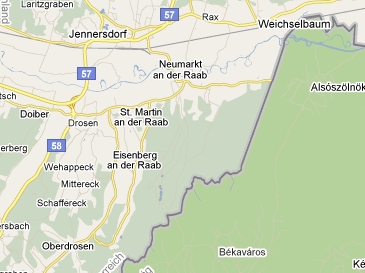 were
much fewer than 133 homes in Eisenberg - about 15. I suspect Vashegy house 133 in the Sankt Martin church records is the
same house that would be found in the BB village lists as house 133 in Neumarkt an der Raab.
were
much fewer than 133 homes in Eisenberg - about 15. I suspect Vashegy house 133 in the Sankt Martin church records is the
same house that would be found in the BB village lists as house 133 in Neumarkt an der Raab. 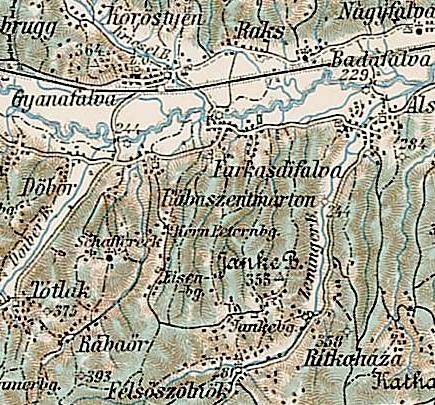 In
my prior article, I had included some map excerpts from the 1910 3rd Military Mapping Survey of Austria-Hungary
that showed the other candidate Eisenberg / Eisenburgs. Here is the corresponding excerpt for this Eisenberg (you should
find it pretty much centered in the bottom half of the excerpt). The advantage of these military maps is that they show
the terrain relief and put little filled rectangles to mark housing. Thus we see that Eisenberg (an der Raab) is at the
upper end of a small valley (perhaps a mile deep) that drains into the Raab. And, as Richard's mother notes, it consists
of very few houses. (As an aside, you can also note that the valley, in 1910, lacked a formal road; instead, there are
just unimproved walking and cart paths in the area.)
In
my prior article, I had included some map excerpts from the 1910 3rd Military Mapping Survey of Austria-Hungary
that showed the other candidate Eisenberg / Eisenburgs. Here is the corresponding excerpt for this Eisenberg (you should
find it pretty much centered in the bottom half of the excerpt). The advantage of these military maps is that they show
the terrain relief and put little filled rectangles to mark housing. Thus we see that Eisenberg (an der Raab) is at the
upper end of a small valley (perhaps a mile deep) that drains into the Raab. And, as Richard's mother notes, it consists
of very few houses. (As an aside, you can also note that the valley, in 1910, lacked a formal road; instead, there are
just unimproved walking and cart paths in the area.) 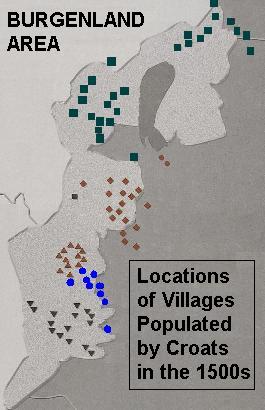 Stadtschlaining)
indicates that it was devastated by the Turks in 1532. This suggests that the Stadtschlaining area likely suffered similar
devastation at that time.
Stadtschlaining)
indicates that it was devastated by the Turks in 1532. This suggests that the Stadtschlaining area likely suffered similar
devastation at that time.